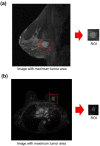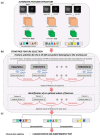Robustness Evaluation of a Deep Learning Model on Sagittal and Axial Breast DCE-MRIs to Predict Pathological Complete Response to Neoadjuvant Chemotherapy
- PMID: 35743737
- PMCID: PMC9225219
- DOI: 10.3390/jpm12060953
Robustness Evaluation of a Deep Learning Model on Sagittal and Axial Breast DCE-MRIs to Predict Pathological Complete Response to Neoadjuvant Chemotherapy
Abstract
To date, some artificial intelligence (AI) methods have exploited Dynamic Contrast-Enhanced Magnetic Resonance Imaging (DCE-MRI) to identify finer tumor properties as potential earlier indicators of pathological Complete Response (pCR) in breast cancer patients undergoing neoadjuvant chemotherapy (NAC). However, they work either for sagittal or axial MRI protocols. More flexible AI tools, to be used easily in clinical practice across various institutions in accordance with its own imaging acquisition protocol, are required. Here, we addressed this topic by developing an AI method based on deep learning in giving an early prediction of pCR at various DCE-MRI protocols (axial and sagittal). Sagittal DCE-MRIs refer to 151 patients (42 pCR; 109 non-pCR) from the public I-SPY1 TRIAL database (DB); axial DCE-MRIs are related to 74 patients (22 pCR; 52 non-pCR) from a private DB provided by Istituto Tumori "Giovanni Paolo II" in Bari (Italy). By merging the features extracted from baseline MRIs with some pre-treatment clinical variables, accuracies of 84.4% and 77.3% and AUC values of 80.3% and 78.0% were achieved on the independent tests related to the public DB and the private DB, respectively. Overall, the presented method has shown to be robust regardless of the specific MRI protocol.
Keywords: deep learning; early prediction; magnetic resonance imaging; pathological complete response.
Conflict of interest statement
The authors declare no conflict of interest.
Figures


References
-
- Minarikova L., Bogner W., Pinker K., Valkovič L., Zaric O., Bago-Horvath Z., Bartsch R., Helbich T.H., Trattnig S., Gruber S. Investigating the prediction value of multiparametric magnetic resonance imaging at 3 T in response to neoadjuvant chemotherapy in breast cancer. Eur. Radiol. 2017;27:1901–1911. doi: 10.1007/s00330-016-4565-2. - DOI - PMC - PubMed
-
- Nguyen A.A.T., Arasu V.A., Strand F., Li W., Onishi N., Gibbs J., Jones E.F., Joe B.N., Esserman L.J., Newitt D.C., et al. Comparison of segmentation methods in assessing background parenchymal enhancement as a biomarker for response to neoadjuvant therapy. Tomography. 2020;6:101–110. doi: 10.18383/j.tom.2020.00009. - DOI - PMC - PubMed
-
- Goldhirsch A., Winer E.P., Coates A.S., Gelber R.D., Piccart-Gebhart M., Thürlimann B., Senn H.-J. Personalizing the treatment of women with early breast cancer: Highlights of the st gallen international expert consensus on the primary therapy of early breast Cancer 2013. Ann. Oncol. 2013;24:2206–2223. doi: 10.1093/annonc/mdt303. - DOI - PMC - PubMed
LinkOut - more resources
Full Text Sources
Miscellaneous

